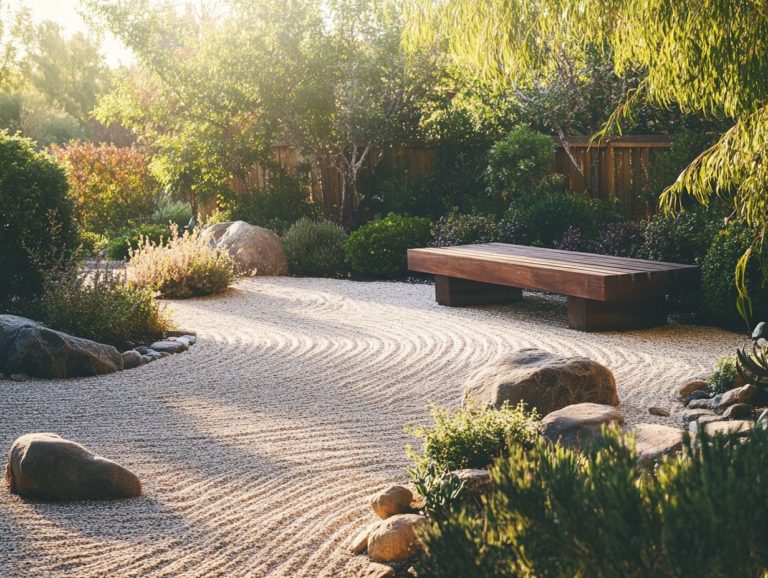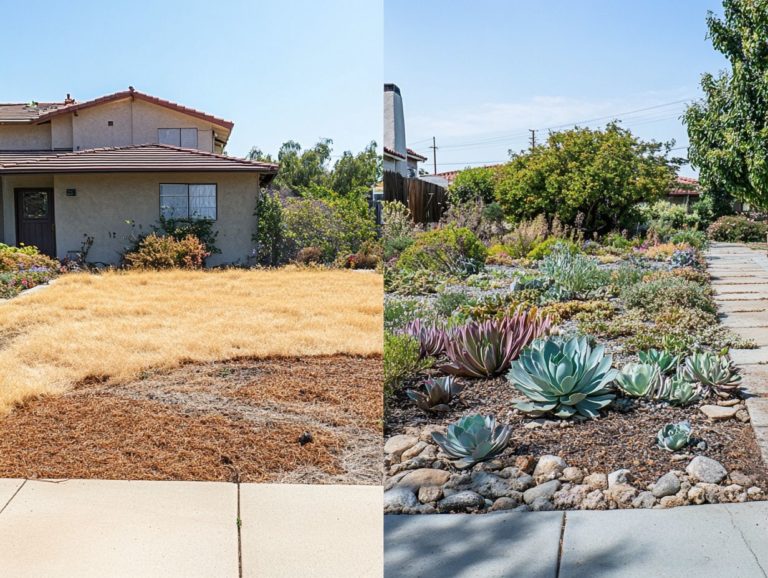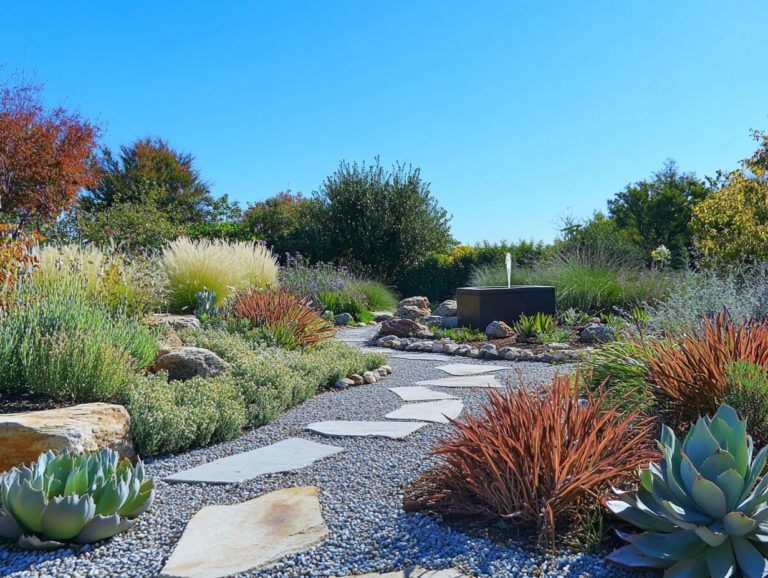Best Mulching Practices for Drought Areas
In regions where water is scarce, adopting effective gardening strategies becomes essential for your success, especially in areas affected by flash drought.
Get ready to unlock the secrets of mulching and discover how it can save your garden during drought! Mulching stands out as a powerful method to protect your soil, conserve precious moisture, and foster robust plant growth. This guide offers step-by-step instructions on how to apply mulch properly, ensuring that your garden thrives even in challenging conditions.
We ll also cover common pitfalls to avoid and explore alternative water conservation methods that can further enhance your gardening efforts. Prepare to elevate your garden s resilience against drought!
Contents
- Key Takeaways:
- Mulching in Drought Areas
- Types of Mulch for Drought Areas
- Benefits of Mulching in Drought Areas
- How to Properly Mulch in Drought Areas
- Mulching Mistakes to Avoid
- Alternative Water Conservation Methods
- Frequently Asked Questions
- What are some of the best mulching practices for drought areas?
- Why is mulching important for drought areas?
- How thick should mulch be applied in drought areas?
- What types of mulch are best for drought areas?
- Can mulching help conserve water in drought areas?
- Are there any other benefits to mulching in drought areas?
Key Takeaways:
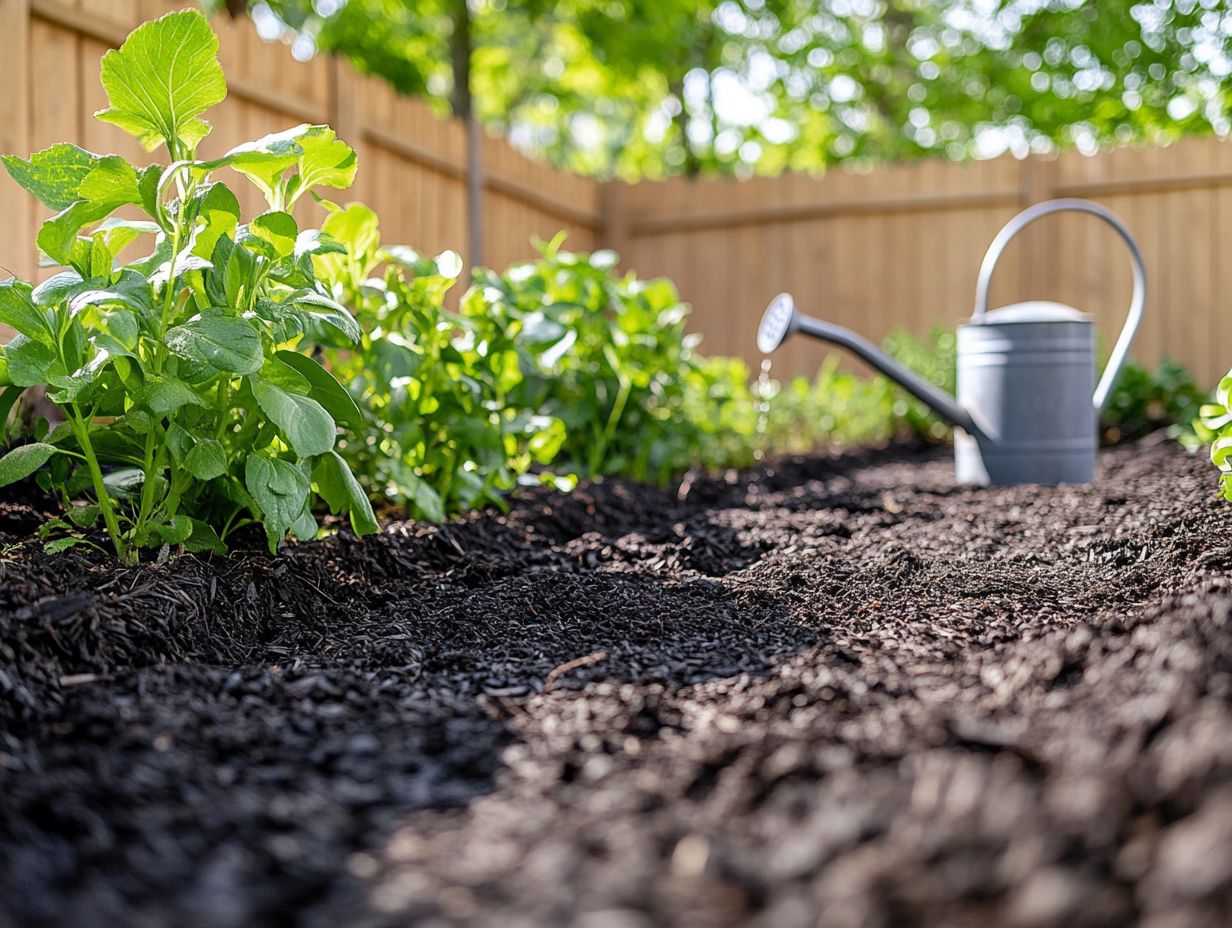
- Select the right mulch to save water and boost plant health!
- Properly mulching in drought areas can help prevent common mistakes that can harm your plants.
- Consider using alternative water conservation methods, such as drip irrigation or collecting and reusing greywater, to further protect your garden in times of drought.
Mulching in Drought Areas
Mulching in drought-prone areas is a sustainable strategy that not only enhances soil quality but also conserves precious water resources. For those looking to learn how to mulch for drought-resistant plants, this practice is essential for gardeners in regions such as California, where flash droughts can strike unexpectedly.
By exploring a variety of mulch options, including organic materials and simple mulching methods, you can greatly improve water efficiency and ensure your plants flourish, even in the face of challenging environmental conditions.
What is Mulching and Why is it Important?
Mulching is an essential practice that involves covering the soil surface with either organic or non-organic materials to elevate soil quality, conserve moisture, and keep weeds at bay. This fundamental gardening technique not only enriches soil nutrients but also establishes a moisture barrier that retains water during dry spells.
You have a variety of mulch types at your disposal, such as straw, wood chips, and shredded leaves. Each offers unique advantages for garden management. Organic mulches think grass clippings and compost are particularly valuable, as they improve soil fertility and structure through their gradual decomposition. This process releases essential nutrients back into the earth. These materials also nurture beneficial microorganisms that contribute to overall soil health.
On the other hand, non-organic options like stones or plastic can effectively suppress weeds and regulate soil temperature, serving multifunctional roles that enrich the ecosystem within your garden. Embracing the right type of mulch will not only enhance the beauty of your garden but also foster a thriving, efficient environment.
Types of Mulch for Drought Areas
When exploring mulch options for drought-prone areas, you have the choice between organic and non-organic varieties, each offering distinct advantages tailored to your landscape’s needs.
Organic mulches, such as wood chips and straw, enrich the soil as they decompose, contributing to its overall health. In contrast, non-organic options like gravel excel at suppressing weeds and retaining moisture without the worry of decomposition.
Organic vs. Inorganic Mulch
Organic mulch, such as compost, grass clippings, and cardboard, boosts your garden s health by improving soil structure and fertility. In contrast, inorganic mulch options like rubber and landscape fabric offer durability and require less maintenance. Your choice between these types depends on your gardening goals, sustainability practices, and the specific needs of your plants.
Organic options break down over time, releasing essential nutrients that support plant growth while nurturing beneficial microorganisms for better soil health. Just remember, they need periodic replenishment as they decompose.
On the other hand, inorganic mulches excel at suppressing weeds and conserving moisture, but they lack nutritional benefits for the soil. Improper disposal can harm the environment. It’s crucial to consider the plants you re growing. Some thrive on organic materials and benefit from added nutrients, while others may do better with the stability and long-term protection that inorganic options offer.
Benefits of Mulching in Drought Areas
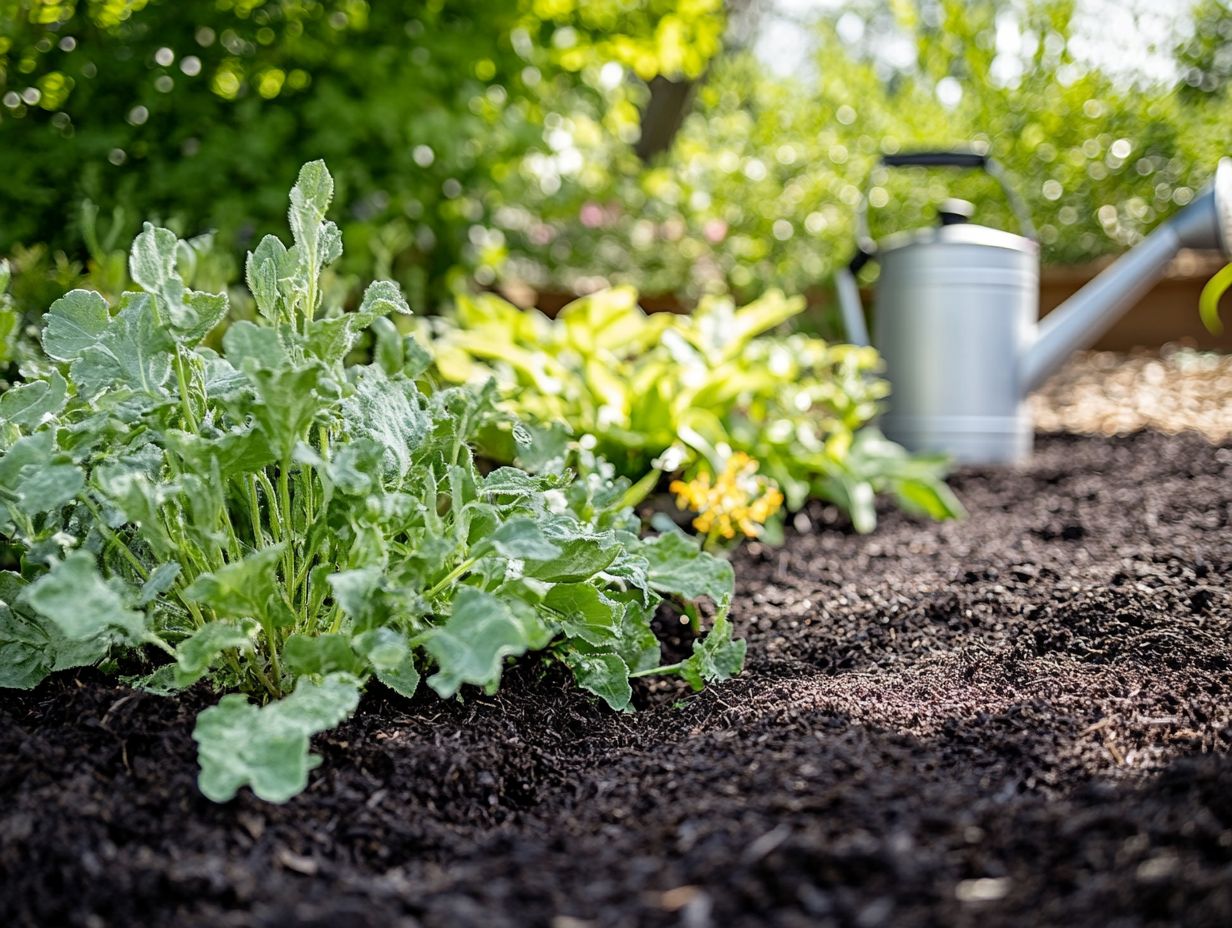
Mulching in drought-prone areas offers many advantages, like saving water and helping plants thrive, while also enriching soil fertility.
Mulch creates a moisture-efficient environment, playing a critical role in retaining essential water resources. This is especially important for establishing and sustaining top cover crops for drought-prone areas in tough climatic conditions.
Conserving Water and Promoting Plant Growth
Saving water is essential during drought conditions, and mulching is a powerful ally. By creating a moisture barrier, mulch significantly reduces evaporation, which promotes healthy plant growth. To enhance your efforts, consider following the best practices for fertilizing drought plants. When you choose organic materials as mulch, you not only improve soil structure but also support a variety of plant life, even in busy areas.
Using effective mulching strategies helps regulate soil temperature, which affects how well plants grow, especially during extreme weather changes. A well-placed layer of mulch conserves moisture and suppresses weed growth, reducing competition for valuable water and nutrients.
When selecting the right mulch, consider the unique needs of your plants. For instance, straw or wood chips are great for perennial beds, while shredded leaves benefit annuals. Apply mulch at a depth of around two to four inches to maximize its benefits without suffocating your plants.
How to Properly Mulch in Drought Areas
Proper mulching techniques are vital for unlocking the full benefits of mulch, especially in drought-prone areas. Using strategies like laying down a cardboard layer and incorporating worm castings natural fertilizer produced by worms can greatly improve soil health.
Following best planting practices and ensuring good soil aeration helps create an ideal environment for plant growth.
Step-by-Step Guide
To effectively mulch, start by laying down cardboard to suppress weeds and create a moisture barrier. Next, create planting holes for your plants and choose the right mulch to cover the soil. By following these steps, you ll enjoy the benefits of mulching in your garden.
It s important to select the right type of mulch based on the area of your garden. For vegetable gardens, organic materials like straw or shredded leaves enrich the soil as they decompose. Conversely, decorative stone mulch works well for ornamental beds, providing both beauty and durability.
When applying mulch, aim for a thickness of 2 to 4 inches around your plants. Avoid piling it against the stems to promote healthy growth. Refreshing the mulch layer each season will help maintain its effectiveness, ensuring your plants thrive all year round.
Mulching Mistakes to Avoid
Avoiding common mulching mistakes is crucial for effective soil management. Errors like applying too much mulch or failing to block weed seeds can negatively impact plant health and water conservation.
Stay informed about these potential pitfalls to ensure your mulching efforts yield the best results for your garden. Start mulching today to see the difference!
Common Errors and How to Prevent Them
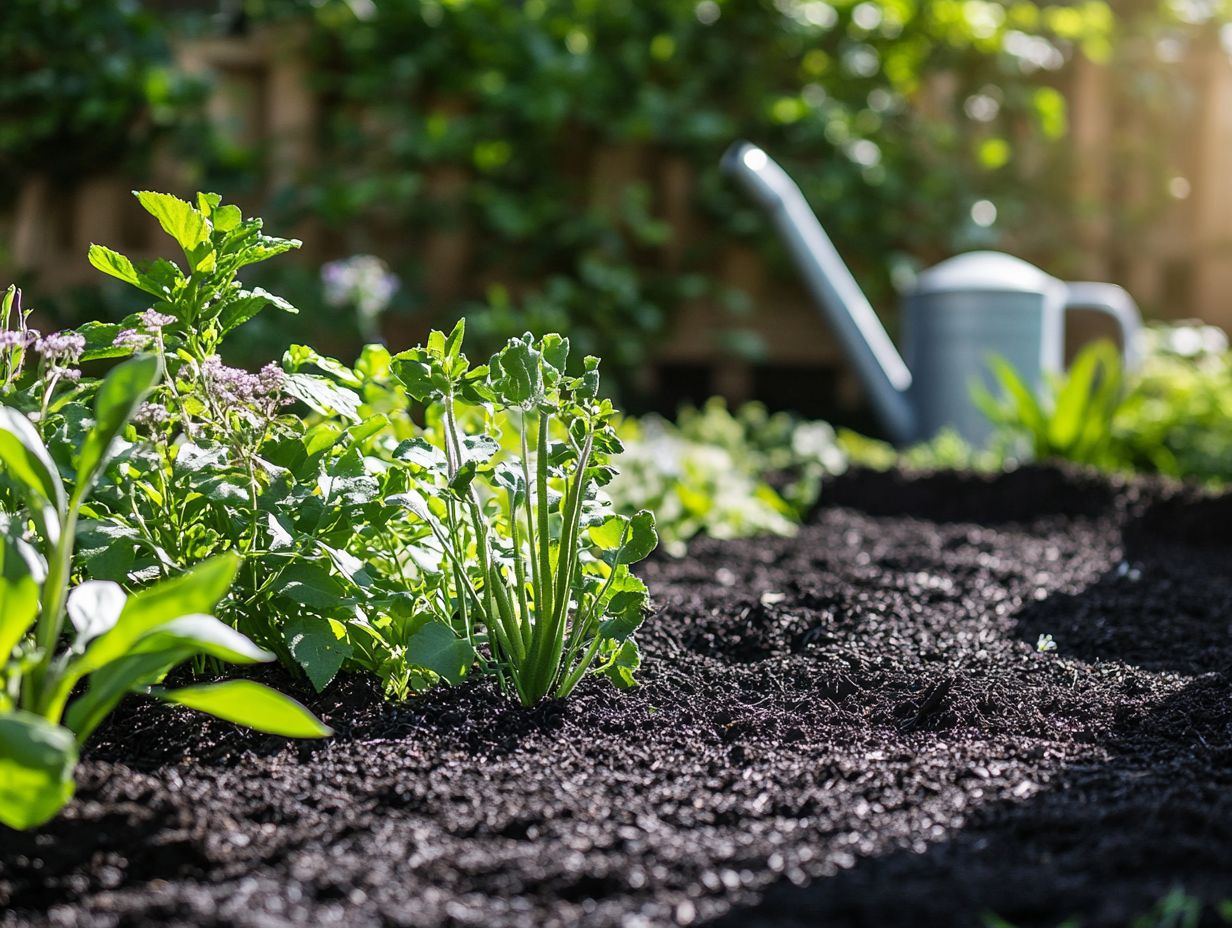
Common mulching errors can undermine your gardening efforts, such as improper application that leads to increased weed growth and less moisture retention. Ultimately, this can harm soil health.
By recognizing these pitfalls and implementing corrective measures, you can boost the effectiveness of your mulching strategy! For example, applying mulch too thickly can suffocate plant roots and invite fungal diseases.
Using the wrong materials might introduce unwelcome pests or toxins. It s vital to select organic mulches like wood chips or straw, as they break down over time and enrich the soil. Aim for mulch layers of about two to four inches; this effectively suppresses weeds while ensuring good air circulation.
Regularly refreshing or replacing your mulch enhances the visual appeal of your garden. It also optimizes moisture retention and nutrient availability.
Alternative Water Conservation Methods
Besides mulching, you have a variety of water conservation methods at your disposal. Consider implementing efficient irrigation practices and utilizing cover crop mulch to enhance soil moisture retention.
These techniques align with permaculture principles, which focus on sustainable and self-sufficient agricultural systems. They also elevate the sustainability of your garden, particularly in drought-prone areas.
Other Techniques for Drought-Proofing Your Garden
Drought-proofing your garden can be an artful endeavor. Use various techniques, such as implementing efficient irrigation systems, choosing native plants, and optimizing soil management practices for enhanced moisture retention.
When you combine these strategies with effective mulching, you can cultivate a resilient landscape that thrives even in the toughest conditions. To further bolster resilience, consider incorporating drip irrigation methods that deliver water directly to the root zones.
This minimizes evaporation and runoff. Designing your landscape with swales can guide rainwater toward your plants, promoting deeper groundwater recharge.
Selecting native plants not only supports local wildlife but ensures they are well-suited to your climate and soil types. This translates to needing less water overall.
By focusing on these sustainable practices, you’re actively contributing to soil health and fostering vibrant ecosystems. Ultimately, this leads to a flourishing garden that stands strong against the unpredictability of drought!
Frequently Asked Questions
What are some of the best mulching practices for drought areas?
The best mulching practices for drought areas include using organic materials like wood chips, straw, and leaves. For more effective strategies, consider these landscape maintenance tips for drought areas, which not only conserve moisture but also boost soil health.
Why is mulching important for drought areas?
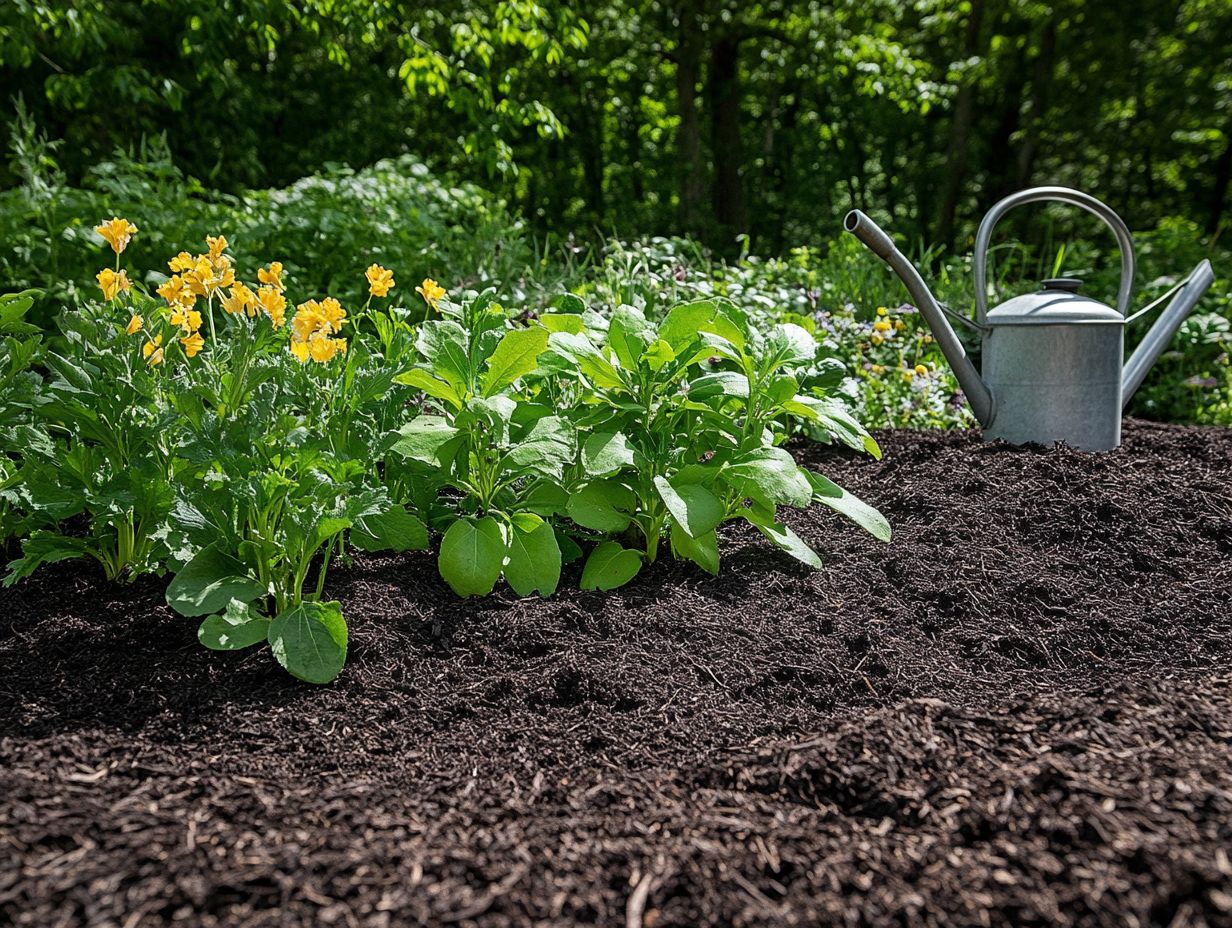
Mulching helps to retain moisture in the soil, reducing the need for frequent watering in drought areas. For optimal results, consider following the best practices for watering drought plants, as it also prevents weeds from competing with plants for water and nutrients.
How thick should mulch be applied in drought areas?
The recommended thickness for mulch in drought areas is 2-3 inches. This provides adequate insulation for the soil, preventing evaporation of moisture and improving water retention, aligning with the best practices for urban drought gardening.
What types of mulch are best for drought areas?
Organic materials like wood chips, straw, and leaves are ideal for mulching in drought areas, as they break down slowly and provide long-term benefits to the soil and plants. Utilizing the benefits of mulching in drought gardening can enhance your gardening efforts significantly.
Can mulching help conserve water in drought areas?
Yes, mulching is an effective way to conserve water in drought areas. By retaining moisture in the soil, it reduces the need for frequent watering and helps plants survive during extended dry periods. For more tips, consider exploring planting strategies for drought conditions.
Are there any other benefits to mulching in drought areas?
Yes, in addition to conserving water, mulching improves soil health, prevents soil erosion, and regulates soil temperature. It also adds organic matter to the soil, promoting a healthy ecosystem for plants.

